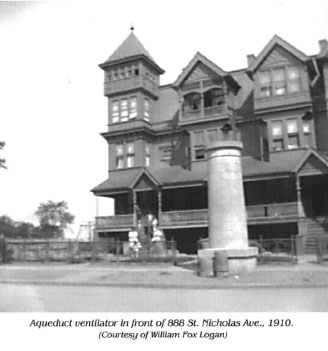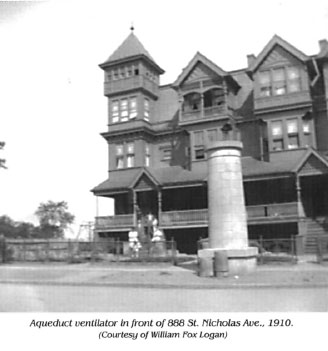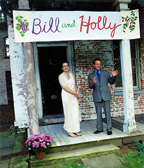
Can a Family Have the Aqueduct in its Genes? Bill Logan is starting to suspect the answer to the above question is yes. Bill has strong ties to the Aqueduct. He is a member of the Board of the Friends, and for 18 years has lived in a house in Hastings whose yard stretches to the trail.
While looking through family photos, Bill came upon a batch of negatives and had them developed. Among the resulting prints was the astonishing picture produced here, taken about 1910. It shows the rambling, turreted, multi-story home of his great-grandparents at 888 St. Nicholas Avenue, on the east side of the avenue between 154th and 155th St. in Manhattan. Directly in front of this exuberant structure is, unmistakably, a ventilator of the Old Croton Aqueduct, in apparently pristine condition. Bill identified the address from the envelope in which he found the negatives. 
The house was a few block south of Coogan's Bluff, a name that will resonate with New York baseball buffs as the fabled cliff from which generations of Giants fans watched the games at the Polo Grounds below. The Aqueduct ran right past the clifftop, which is at the south end of Highbridge Park, so the location of a ventilator in front of the house - just a little farther along the tunnel route - makes perfect sense. Today there is no trace of either structure at the site, now occupied by the New York City Department of Environmental Protection facility.

Ventilators, conical stone towers about 20 feet high, were placed about a mile apart along the Aqueduct "to give free circulation of air through the Aqueduct," in the words of the chief engineer John Jervis. Approximately every third ventilator had a door in its base, permitting workers direct access into the tunnel. Most of the Westchester towers still stand like friendly sentinels along the trail, some with the names of the contractors and engineers who worked n that section of the Aqueduct inscribed into the stone. But until now the location of any of the towers south of the present Westchester-New York City boundary was unknown, other than those at both ends of the High Bridge.
Getting back to the Logans, in addition to Bill's great-grandparents, his grandfather and his great-great-grandmother lived in the house on St. Nicholas Avenue. That's three generations, and if you add the Hastings residency of Bill and his children, it make s total of five generations of the Logan family who have lived next to the Aqueduct. Only Bill's father missed out, since he visited the St. Nicholas Avenue house but didn't live there.

Even that is not the end of the story. Bill, an architect, played a major role in the improvements made at the Keeper's House n the late 1990s by Friends of the Aqueduct volunteers. On one of those summer workdays he met and later married Holly Daly, an active Friends member who was then living in a house backing up to the Aqueduct in Dobbs Ferry. Holly is a board member and the Friends' membership secretary.
If any readers have similar treasures in their own family archives, please get in touch. This is one of the best means of uncovering more Aqueduct history. Reprinted from the Winter 2003 issue of the Friends of the Old Croton Aqueduct Newsletter.

